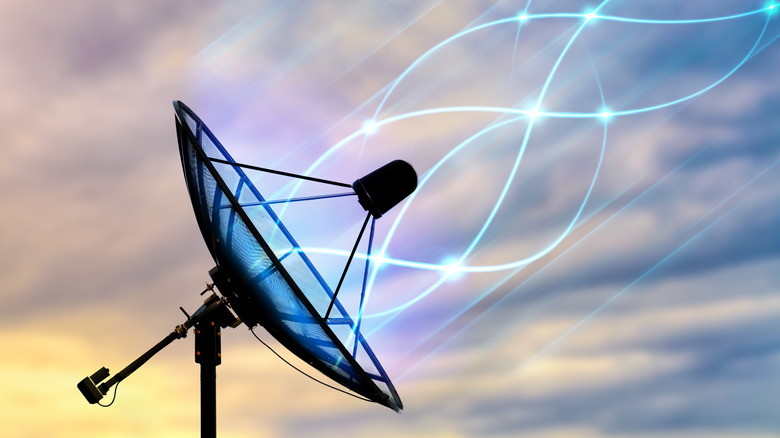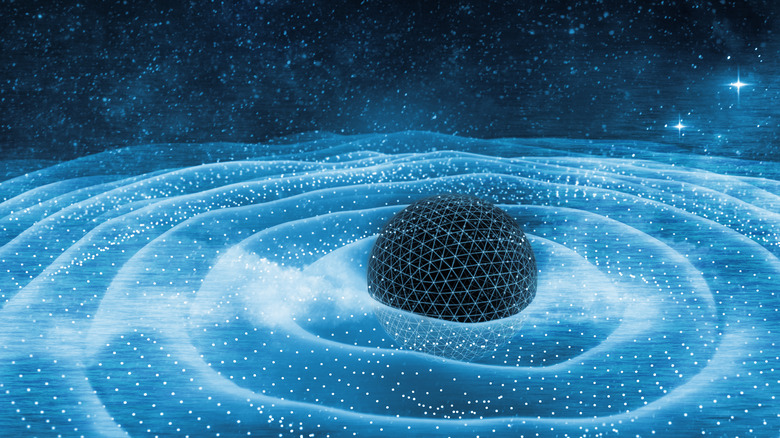How This Giant Laser Could Be Used To Find Evidence Of Aliens
The search for extraterrestrial life isn't limited to robots digging around in the giant sandbox we call Mars. In fact, scientists involved in SETI — the search for extraterrestrial intelligence — have been using a variety of radio telescopes for decades to look for signals of alien origin. They haven't picked up anything definitive yet, but from time to time they find something that makes them say, "Wow!" Now, according to new research published on the arXiv preprint database, scientists may have a new listening tool: gravity itself.
Many types of telescopes have been used to look for signs of alien life, from the ground-based Allen Telescope Array to the space-based James Webb Space Telescope. While these high-tech instruments differ in some pretty significant ways, they all make their observations using the electromagnet (EM) spectrum, which is a dressed-up way of saying they look at light waves. The EM spectrum encompasses all types of light waves, including not only those that can be seen by human eyes (visible light waves) but also low-frequency waves (radio waves, infrared light) and high-frequency waves (ultraviolet light, X-rays).
When very massive bodies — think neutron stars and black holes — move through space, they also make waves, not unlike ripples in a pond. Crucially, these unique waves, aptly called gravitational waves, are distinct and totally separate from the EM spectrum, meaning that traditional telescopes are completely blind to them. Luckily, we know how to build gravitational wave detectors, with a few already operating.
Bigger is better
The LIGO observatory consists of a pair of gravitational wave detectors, one in Louisiana and one in Washington. Each detector forms an L shape, where each arm is a tunnel two-and-a-half miles long. A single laser beam is split and sent down each tunnel. At each tunnel's end is a mirror, which then sends the laser back. Normally, both beams would return to the detector simultaneously. But if a gravitational wave passes while the detector is on, the path of the beams becomes distorted. Scientists use these distortions to learn about distant objects.
There are other gravitational wave detectors, including the Virgo in Europe and KAGRA in Japan. Unfortunately, none are advanced enough to find alien life, according to the research. NASA is working with the ESA on the space-based LISA observatory, scheduled for the 2030s. LISA will be an array of three spacecraft separated by millions of miles, as opposed to the 1,850 or so miles between the two LIGO detectors, according to NASA. LISA's spacecraft will exchange laser beams with each other to detect spacetime distortions caused by gravitational waves. But even this won't be big enough to get the job done.
If the LISA mission is a success, it will be followed by even more advanced detectors. The Big Bang Observer (BBO) is one of the proposals, while Japan is working on the DECIGO antenna of a similar magnitude. While LIGO's size is impressive, these observatories would have arm lengths hundreds or even thousands of times longer.
What's the payoff?
If the necessary detectors are two generations — and likely several decades and billions of dollars — away, the payoff better be pretty spectacular. So what exactly can we expect them to detect? According to the paper's authors, these observatories would be well suited for finding giant alien engineering projects, called megastructures.
They suggest we could look for alien structures about as massive as Jupiter and traveling at around 10% the speed of light. While Jupiter is pretty enormous, it's orders of magnitude smaller than the objects observed using gravitational waves today. And 10% the speed of light is unfathomably fast — roughly 67 million miles per hour — but it's well below the threshold of sci-fi technology. Our observational range for these types of objects would extend all the way to the Andromeda galaxy, which is pretty far out no matter how you slice it. Less massive structures, about the size of Mercury, might be detectable within 10 parsecs, which is a volume that includes more than 400 stars (via Sol Station).
If aliens are traveling around in massive, superfast spaceships, not only might we be able to detect them, but we could even potentially reverse engineer the technology, according to the paper. Of course, all of this assumes that there are aliens to detect in the first place, which isn't a given by any means. Until these observatories are operational, the best place to find evidence of life might be closer to home.


